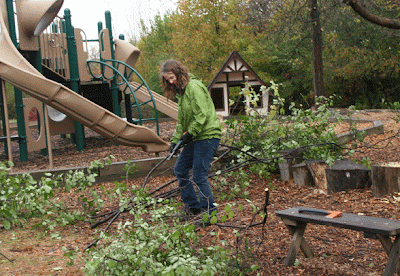 |
| Oregano with frost |
Ever wonder why some herbs are popular in summer while others only cross our thinking in winter? Why are sage and hyssop used mostly in winter?
 |
| Hyssop, taken early morning before the frost melted. |
When I visited India a few years back, I learned that Indian cooking pays more attention to seasonal herbs and spices than we do here in the U.S. My hosts showed me various seasoning mixes, some created specifically for summer, their properties causing the body to cool, while the winter mixtures were meant to warm the body. My friends explained that if you used a summer garam masala in winter, for example, you would be chilly and uncomfortable.
 |
| Rosemary (this variety is 'Barbecue'). |
The traditional winter herbs we think of around the holidays, such as sage, rosemary, thyme and hyssop, are herbs that warm the body. They're typically European herbs, coming from places that are cold in winter, places where winter foods historically included fat roasted goose, pork, bacon, ham.
 |
| Fennel |
Those fatty foods were perfect for adding calories to the diet, building body fat to help keep the body warm in a cold climate. With those heavy foods, herbs were added to counteract the animal fats. With roast goose, for example, hyssop was the traditional herb to help tone down the taste of the greasy taste.
 |
| Garden sage |
Sage has long been used as a sore throat gargle in winter. It's a warming, pleasantly bitter tea, sweetened with honey, that is amazing refreshing after being outdoors for a long walk.
 |
| Lemon Thyme |
Thyme, another winter herb, is evergreen in my climate (Zone 6-b). Even with a hard freeze and frost, this incredible herb keeps right on growing. You likely know it as one of the ingredients in poultry seasoning and its warming flavor is most welcome in stuffing or dressing served with holiday turkey. But did you know thyme is an excellent gargle for sore gums or little cuts in the mouth? If you read the ingredients on the Listerine bottle, you'll see thymol, or oil of thyme, as the primary active ingredient.
Rosemary is also considered a warming herb. While you may use rosemary in summer on occasion, it comes into its own in winter as another ingredient in some poultry and pork seasonings.
Mixed together, these herbs will warm the body and add flavor to winter meals. Here's a recipe to make your own poultry seasoning from my book, Great Herb Mixes. (Cutting corners before Thanksgiving, I looked in the grocery store for a container of poultry seasoning. I was disappointed to find a little jar of McCormick poultry seasoning, less than 2 tablespoons full, for $2.59; I choose to make my own!) My book has 4 poultry seasoning recipes (plus another 96 of other kinds). Here's the recipe. Herbs are dried.
2 Tablespoons each: Sage, Parsley, Celery leaf and Marjoram.
1 Tablespoon Summer Savory
1 Tablespoon Thyme
Mix together and grind to a powder in a food processor. Store in airtight container. Use 2-3 teaspoons for a chicken added in the last half hour of cooking time.
Stay warm!


































